Barack Obama leads John McCain not only in overall support but also in the intensity of his support. A sizable plurality of 45% says they are voting for Obama and that there is no chance they will vote for McCain. McCain’s “certain” support is much smaller: just 32% are certain to vote for him. Similarly, 36% say they strongly back Obama, while just 21% strongly support McCain.
 Obama also holds an advantage in the proportion of voters who say their vote is cast more in support of him than against his opponent. Among Obama supporters, 77% say they are voting more for him than against McCain. Fewer of McCain’s voters (64%) are positive voters, while 30% say that their vote is mostly a vote against Barack Obama.
Obama also holds an advantage in the proportion of voters who say their vote is cast more in support of him than against his opponent. Among Obama supporters, 77% say they are voting more for him than against McCain. Fewer of McCain’s voters (64%) are positive voters, while 30% say that their vote is mostly a vote against Barack Obama.
Over the past month, Obama has made gains across a number of political and demographic groups. For the first time, he holds a substantial lead among political independents (51% to 33% for McCain). McCain held a slight edge among independents in mid-September (45% to 38%).
Obama also has drawn even with McCain among white voters (45% to 45%). In the Sept. 9-14 survey, the first conducted after the party conventions, McCain led Obama among white voters by 14 points (52% to 38%). Notably, McCain’s advantage among white non-college graduates also has almost disappeared over this period (from 16 points in mid-September to four points in the current survey).
Young voters – those under age 30 – continue to overwhelmingly support Obama (66% vs. 27% for McCain). Obama now also leads among older age groups as well – with the exception of those 65 and older, who are evenly split (44% Obama, 44% McCain). White voters ages 50 and older tilt to McCain, but Obama also has made gains among these voters since mid-September.
Obama also leads 52% to 37% in the political battleground states. Notably, Bush won 10 of these 15 politically contested states in 2004, by margins ranging from less than 1% (Iowa and New Mexico) to 21% (Indiana). John Kerry won five of these states – all by less than 4%.

Religion and the Vote
As in previous elections, differences in voting patterns by religion are amplified when church attendance is taken into account. Obama has made no headway among white evangelical Protestants who attend church at least once a week; just 17% of this group supports him. By contrast, 37% of white evangelicals who attend services less frequently support Obama.
Similarly, while he has made gains among Catholics overall, Obama runs even with McCain among observant white Catholics (45% to 45%). He now has a clear lead among white Catholics who attend Mass less frequently (53% to 38%).
Proportion of ‘Strong’ Support
The Democratic ticket enjoys a lead not only in overall support among voters but also an enthusiasm advantage. Currently, 36% of registered voters say they support Obama strongly, compared with 21% who support McCain strongly. A month ago, in the aftermath of the party conventions, the candidates were much closer in strength of support.
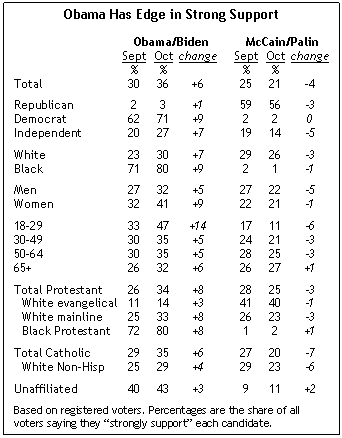
About seven-in-ten Democrats (71%) say they support their party’s ticket strongly; among Republicans, 56% give strong support to their ticket. McCain draws particularly strong support from white evangelical Protestants (40%). For Obama, three groups stand out in terms of strength of support: African Americans (80% strong support); voters ages 18-29 (47% strong); and secular and unaffiliated voters (43% strong).
Where the Swing Vote Stands
While Obama holds a substantial lead in the poll, many voters remain persuadable. Nearly one-in-four (23%) are classified as swing voters, exactly the same percentage as Pew found two weeks before the 2000 presidential election – an election that, like this one, featured no incumbent in the race. However, unlike in 2000, committed voters today favor the Democrat by a significant margin (45% Obama, 32% McCain). Still, the proportion of swing voters is large enough to possibly change the election should they break overwhelmingly in a Republican direction. About one-in-ten voters (9%) say they are completely undecided at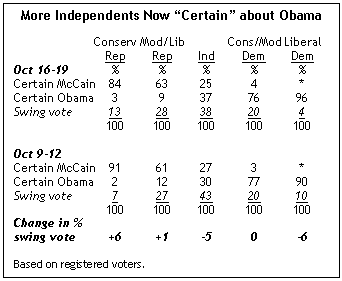 this point.
this point.
Obama has gained seven points in “certain” support among independents (now 37%, up from 30% a week ago), while McCain essentially held steady (25% certain now compared with 27% last week). Obama has solidified his position among liberal Democrats (now 96%, up from 90%), while McCain slipped slightly among conservative Republicans (now 84%, down from 91%).
There is little indication in the poll as to how swing voters will eventually break. They are demographically very similar to the electorate as a whole.
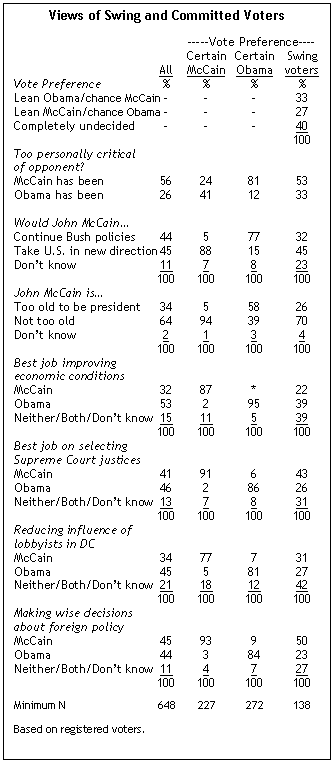 Swing voters who have expressed a preference between the candidates divide roughly evenly between the two men (33% for Obama, 27% for McCain). Swing voters are considerably more critical of McCain’s campaign than they are of Obama’s: 53% say McCain has been too personally critical of Obama, while just 33% say Obama has been too negative. At the same time, however, more swing voters say they see McCain as offering a change from President Bush’s policies (45%) than say he will continue Bush’s policies (32%).
Swing voters who have expressed a preference between the candidates divide roughly evenly between the two men (33% for Obama, 27% for McCain). Swing voters are considerably more critical of McCain’s campaign than they are of Obama’s: 53% say McCain has been too personally critical of Obama, while just 33% say Obama has been too negative. At the same time, however, more swing voters say they see McCain as offering a change from President Bush’s policies (45%) than say he will continue Bush’s policies (32%).
Swing voters prefer McCain on foreign policy, terrorism and Iraq, as well as on selecting future Supreme Court justices. Obama leads on the economy, education, health care, and the environment. Swing voters are divided as to which candidate can best reduce the influence of lobbyists.
Voters See Obama as Most Likely to Win
Though voters saw the race as a toss-up in mid-September, many more now see Barack Obama as “most likely to win” the election. About six-in-ten (61%) see Obama as most likely to win, compared with 17% who say they see McCain winning; 22% did not offer an opinion.
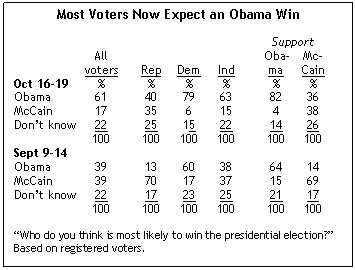 In mid-September, 39% said McCain was most likely to win and the same percentage said they expected an Obama victory. Currently, as many voters say that Obama will win as said that about Bill Clinton in October 1992, a few weeks before he won his race against the first President Bush.
In mid-September, 39% said McCain was most likely to win and the same percentage said they expected an Obama victory. Currently, as many voters say that Obama will win as said that about Bill Clinton in October 1992, a few weeks before he won his race against the first President Bush.
McCain supporters are far less confident of victory than they were in mid-September, following the GOP convention. Those who say they support McCain are about as likely to say he will win as they are to say the same of Obama (38% compared with 36%). That is down significantly from September, when 69% of those supporting McCain said they thought their candidate was most likely to win.
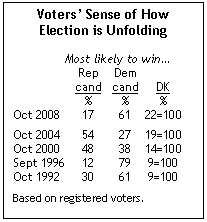 Democrats, meanwhile, are increasingly optimistic about Obama’s chances. In mid-September, six-in-ten saw him as most likely to win. In October, that number has risen to close to eight-in-ten (79%). There is a similar increase among people who say they are Obama supporters. While 64% said he was most likely to win in September, now 81% say they think he will win.
Democrats, meanwhile, are increasingly optimistic about Obama’s chances. In mid-September, six-in-ten saw him as most likely to win. In October, that number has risen to close to eight-in-ten (79%). There is a similar increase among people who say they are Obama supporters. While 64% said he was most likely to win in September, now 81% say they think he will win.
Independents also see a likely Obama victory, with more than six-in-ten (63%) predicting that scenario and only 15% saying they expect a McCain win. The group choosing Obama as the likely winner is up 25 points from last month.
Since 1992, voters surveyed in early fall have consistently predicted correctly which candidate would win the election. In October 2004, more than half (54%) said they thought George W. Bush was most likely to win his re-election run. And close to half (48%) thought Bush would win the incredibly close race against Al Gore in 2000. Close to four-in-ten (38%) said at that time they thought Gore was most likely to win.
Voters also predicted the Clinton wins in 1992 and 1996. More than six-in-ten (61%) said they thought Clinton “most likely to win” in 1992. That jumped to 79% who thought Clinton more likely to win in his re-election run against Bob Dole four years later.
Grading the Campaigns
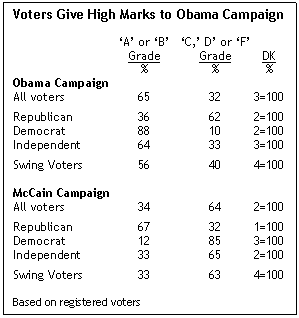 Voters give significantly higher marks to Obama’s campaign than they do to McCain’s. About two-thirds (65%) give Obama A or B grades for the job he is doing convincing them to vote for him. By comparison, just 34% give McCain’s campaign A or B grades. Obama’s presidential campaign is now graded more favorably than any other – Republican or Democratic – in the last 16 years, outpacing the 58% who gave Bill Clinton’s 1992 campaign similar high marks. At 34%, favorable views of McCain’s campaign are low, but still surpass the 1996 Dole campaign – only 29% gave the Kansas senator’s campaign grades of A or B.
Voters give significantly higher marks to Obama’s campaign than they do to McCain’s. About two-thirds (65%) give Obama A or B grades for the job he is doing convincing them to vote for him. By comparison, just 34% give McCain’s campaign A or B grades. Obama’s presidential campaign is now graded more favorably than any other – Republican or Democratic – in the last 16 years, outpacing the 58% who gave Bill Clinton’s 1992 campaign similar high marks. At 34%, favorable views of McCain’s campaign are low, but still surpass the 1996 Dole campaign – only 29% gave the Kansas senator’s campaign grades of A or B.
Nearly nine-in-ten Democrats (88%) offer A or B grades to Obama’s campaign, compared with two-thirds (67%) of Republicans who give McCain’s effort top marks. There is a wide difference among partisans when judging their respective campaigns: 53% of Democrats give Obama A grades compared while only 23% of Republicans give the McCain campaign top marks.
 Independents and swing voters mirror the general voting public in giving higher marks to Obama’s campaign. Just a third of independents and swing voters grade McCain’s election campaign A or B, while more than six-in-ten (64%) give him a C, D or F. Obama does much better among both groups with 64% of independents and 56% of swing voters giving his campaign one of the top grades.
Independents and swing voters mirror the general voting public in giving higher marks to Obama’s campaign. Just a third of independents and swing voters grade McCain’s election campaign A or B, while more than six-in-ten (64%) give him a C, D or F. Obama does much better among both groups with 64% of independents and 56% of swing voters giving his campaign one of the top grades.
McCain’s campaign gets somewhat lower marks than the 2004 George W. Bush campaign, while Obama’s campaign scores about 20 points more favorably than John Kerry’s effort four years ago. The current 31-point gap between how voters rate Obama’s campaign and McCain’s is the largest since Pew began asking the question in 1992.


